January 2025
Outdoor Power Equipment Market (By Power Source: Gasoline, Battery, Electric Corded; By Equipment: Lawnmower, Chainsaw, Trimmer & Edger, Blowers, Tillers & Cultivators, Snow Throwers, Others; By End use: Residential, Commercial/Government) - Global Industry Analysis, Size, Share, Growth, Trends, Regional Outlook, and Forecast 2024-2034
The global outdoor power equipment market size was USD 35 billion in 2023, accounted for USD 36.87 billion in 2024 and is expected to reach around USD 62 billion by 2034, expanding at a CAGR of 5.33% from 2024 to 2034. The North America outdoor power equipment market size reached USD 12.95 billion in 2023. The efficiency, maintenance, and usability of outdoor power equipment are being improved by the integration of cutting-edge technologies like IoT and AI. This is driving the growth of the outdoor power equipment market.
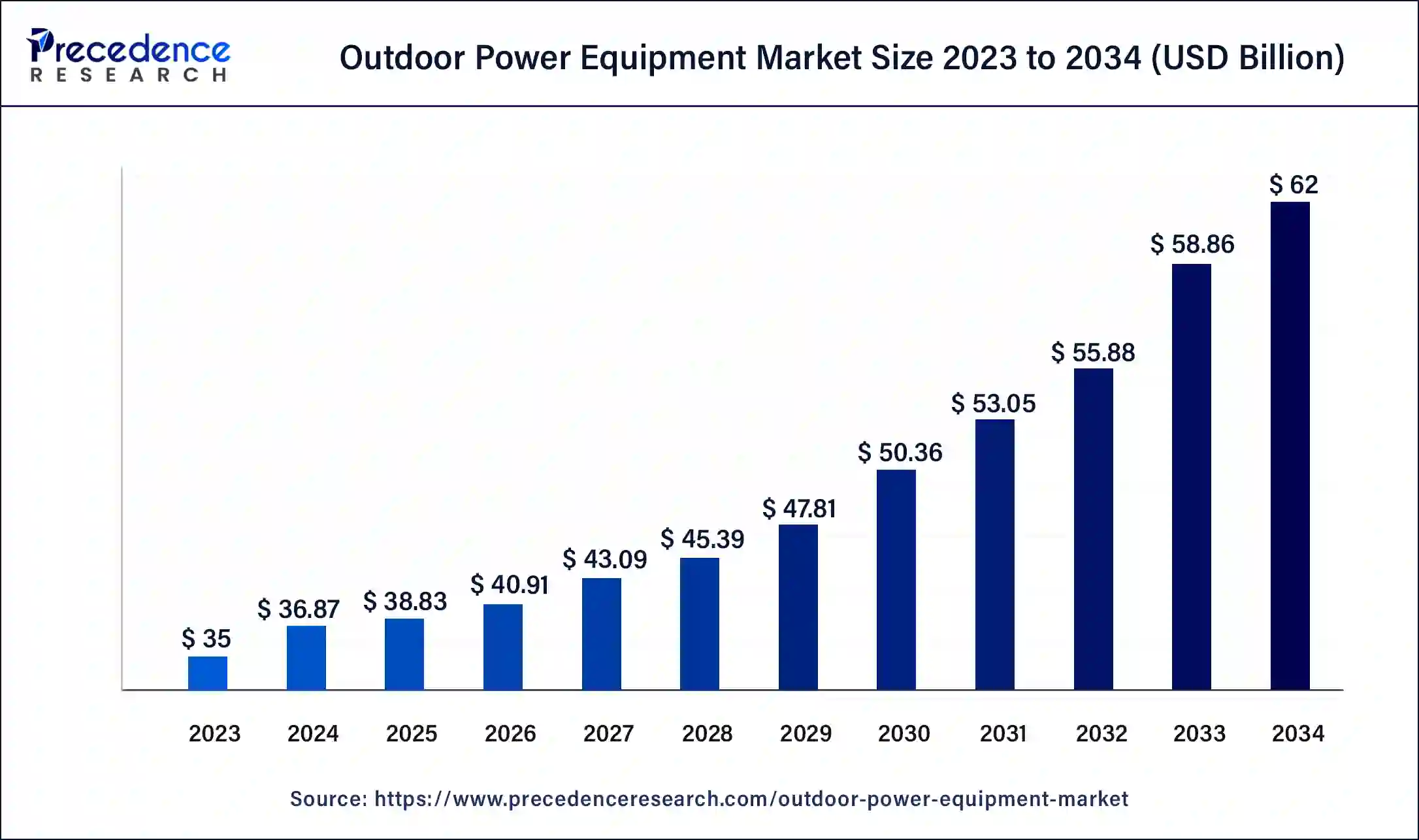
The U.S. outdoor power equipment market size was exhibited at USD 9.71 billion in 2023 and is projected to be worth around USD 7.27 billion by 2034, poised to grow at a CAGR of 5.37% from 2024 to 2034.
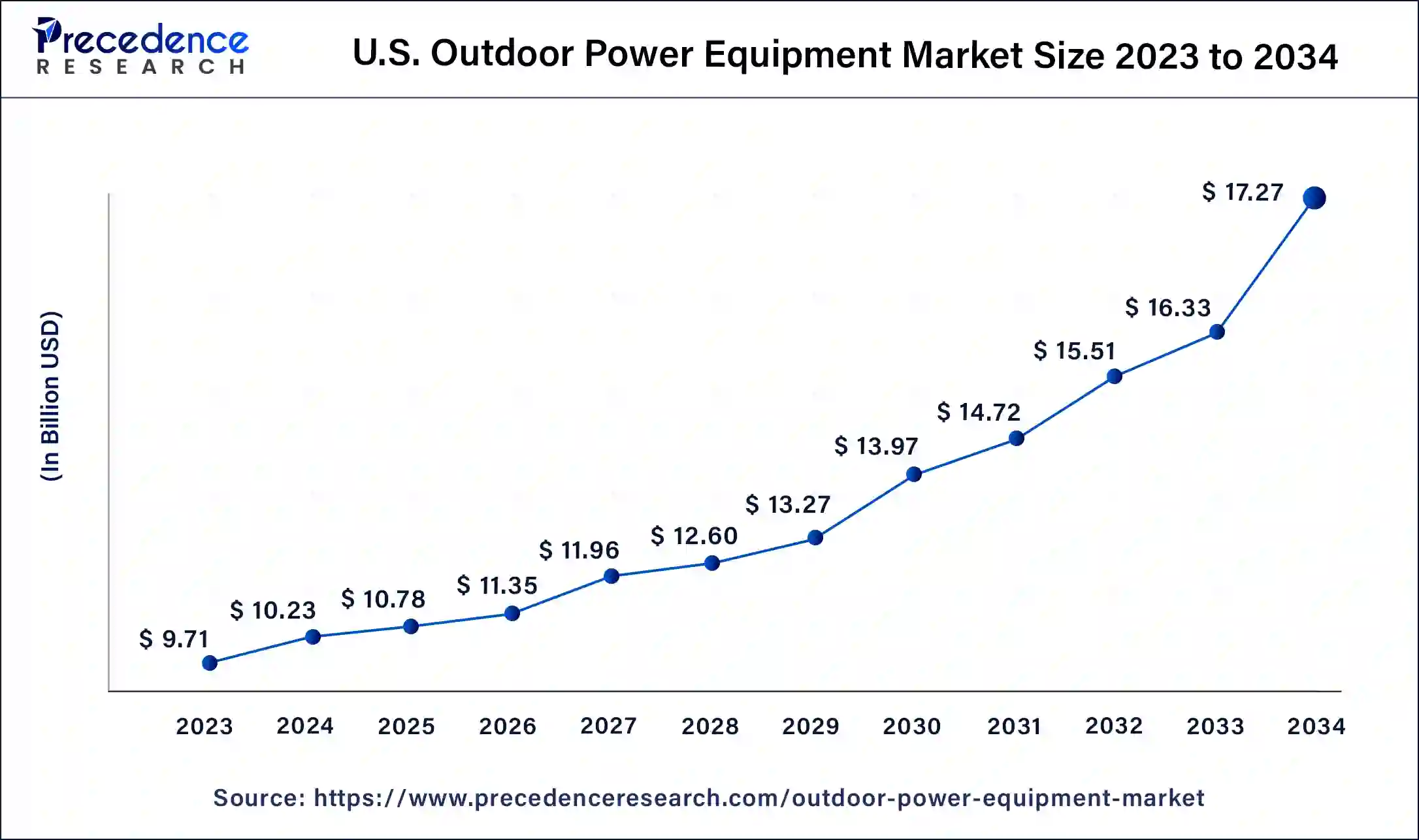
North America held the largest share of the outdoor power equipment market in 2023. The market has been steadily expanding as a result of rising interest in gardening and landscaping projects. Both the residential and business sectors are responsible for this growth. Demand is being driven up by growing urbanization as well as the growing tendency to keep aesthetically beautiful gardens and lawns. The commercial sector, which includes maintenance services for municipalities and landscaping, is still a major driver of industry expansion.
Environmentally friendly alternatives are becoming more popular as the effects of gas-powered equipment on the environment are being scrutinized more closely. Outdoor power equipment is increasingly being integrated with smart technologies and the internet of things (IoT), enabling customers to monitor and manage their equipment from smartphones and other devices.
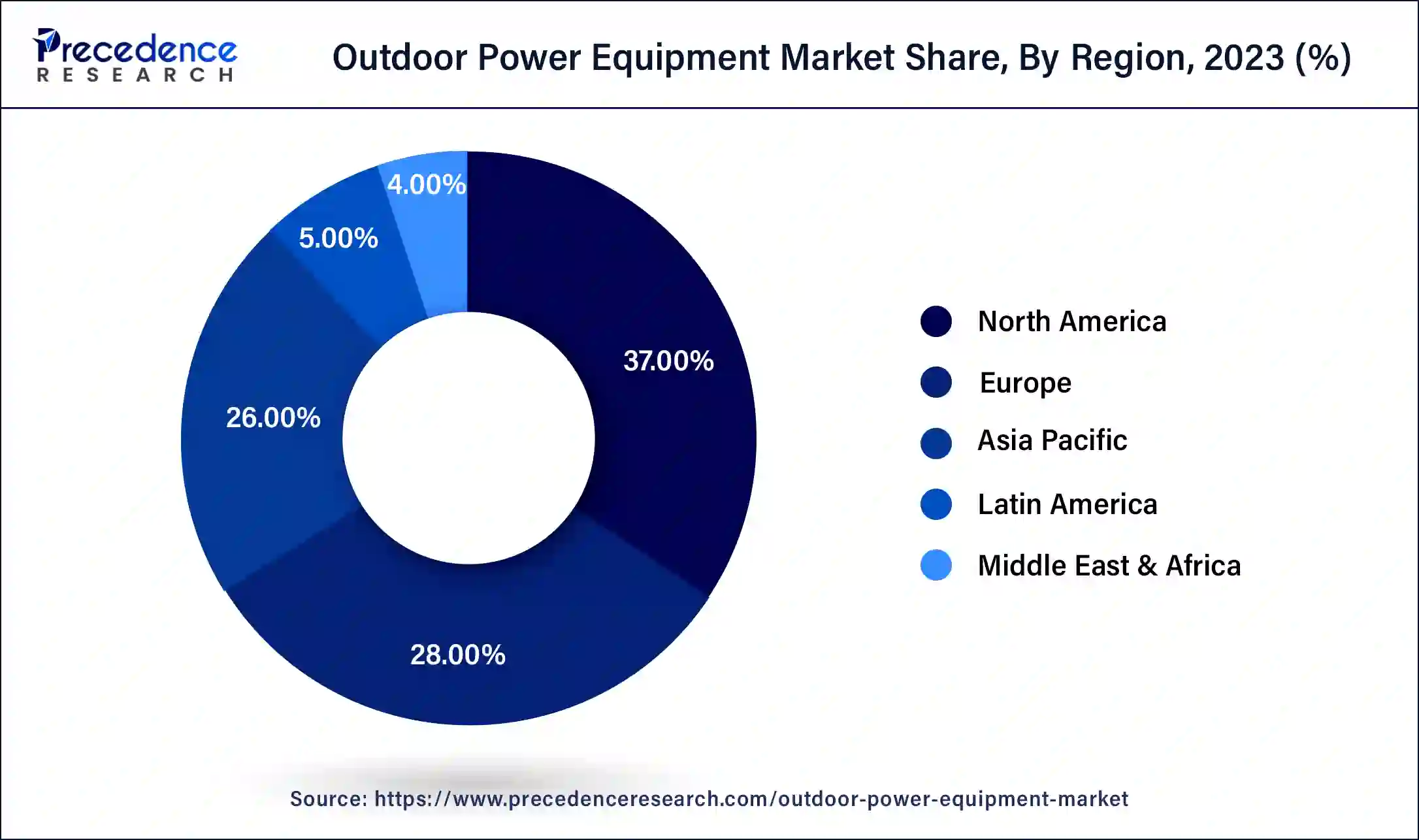
Asia Pacific is expected to host the fastest-growing outdoor power equipment market during the forecast period. Outdoor power equipment is becoming more and more in demand due to ongoing infrastructure development and rapid urbanization in countries like Southeast Asia, India, and China. An assortment of power tools and equipment are required for the growing number of landscaping, construction, and maintenance tasks. Lawnmowers, chainsaws, hedge trimmers, and other gardening tools are in high demand as consumers, particularly in emerging nations, show an increasing trend of investing in home repair and gardening.
The use of electric and battery-powered outdoor power equipment is being encouraged by regulations that aim to reduce emissions and promote the use of eco-friendly equipment. Due to the rise in commercial real estate, golf courses, and public areas, the commercial landscaping and maintenance industries are growing, which is driving up demand for outdoor power equipment of the highest caliber.
The manufacturing, distribution, and retailing of power-driven outdoor tools and machines is referred to as the outdoor power equipment market. Products used for a variety of outdoor sports and maintenance duties are included in this market. Technological developments, rising interest in lawn and garden maintenance, and the need for automated and electric-powered equipment are some of the drivers driving the industry. The market for outdoor power equipment caters to a broad spectrum of consumers, including commercial property managers, professional landscapers, and homeowners. Tools for pulverizing and incorporating nutrients into soil in preparation for planting.
A wide variety of tools and machinery for outdoor hobbies like gardening, landscaping, and other outdoor maintenance jobs are included in the market for outdoor power equipment. Lawnmowers, chainsaws, trimmers, blowers, snow throwers, and other similar instruments are among the equipment found in this sector. Growing demand, especially in the residential and commercial sectors, for gardening and landscaping services has been propelling the global market for outdoor power equipment. Growth in the market is mostly driven by rising urbanization and the growing demand for keeping lawns and gardens at home. The outdoor power equipment market is being driven by innovations that provide convenience and ease of use, like battery-powered and cordless equipment.
| Report Coverage | Details |
| Market Size by 2034 | USD 62 Billion |
| Market Size in 2023 | USD 35 Billion |
| Market Size in 2024 | USD 36.87 Billion |
| Market Growth Rate from 2024 to 2034 | CAGR of 5.33% |
| Largest Market | North America |
| Base Year | 2023 |
| Forecast Period | 2024 to 2034 |
| Segments Covered | Power Source, Equipment, End-use, and Regions |
| Regions Covered | North America, Europe, Asia-Pacific, Latin America, and Middle East & Africa |
Rising demand for landscaping services
The need for well-kept lawns, gardens, and green spaces rises as more people live in cities and as residential constructions spread is driving the outdoor power equipment market. Regular landscaping is necessary to preserve both the functional and aesthetic appeal of businesses and public areas. Parks, office buildings, and recreational spaces are examples of this, which increases the need for outdoor power equipment of the highest caliber. Rising environmental concerns are encouraging sustainable landscaping techniques. Because they are quieter and emit less emissions than their gas-powered counterparts, battery-powered or electric tools are examples of environmentally friendly equipment that is in higher demand. Landscaping jobs are made easier and more efficient by innovations in outdoor power equipment, such as robotic lawnmowers and better battery technologies.
Competition from electric alternatives
The transition from gas-powered to electric outdoor power equipment is being driven by strict emission limits and growing environmental awareness. To lessen their carbon impact, businesses and consumers are looking for environmentally friendly choices. Because electric equipment requires less maintenance, requires less fuel, and has a longer lifespan than its gas-powered counterpart, its total cost of ownership is frequently lower. Its cost-effectiveness appeals to both commercial and consumer users. Electric outdoor power equipment is significantly quieter to operate than gas-powered equipment, which makes it appropriate for use in urban and residential locations where noise pollution is an issue. Electric outdoor power equipment now operates with far greater performance and dependability thanks to advancements in battery technology. Thus hampering the outdoor power equipment market.
Battery-powered equipment
The demand for battery-powered equipment in the outdoor power equipment market, which provides a greener alternative to gasoline-powered tools, is being driven by growing environmental awareness. Battery-powered equipment is becoming more appealing and performing better because of advancements in battery technology, such as batteries with faster charging times and longer lifespans. Consumers and businesses are moving toward battery-powered solutions as a result of stricter rules on emissions and noise pollution. Customers are beginning to favor battery-powered technology more and more because of its portability, affordability, and minimal environmental effects. Although the initial cost of battery-powered equipment is typically higher than that of gas-powered alternatives, over time, battery-powered equipment may prove to be more cost-effective due to decreased maintenance and operating expenses.
The gasoline segment held the largest share of the outdoor power equipment market in 2023. Because of its high-power output and performance, gasoline-powered outdoor equipment is preferred, including lawnmowers, chainsaws, and generators. Because these instruments frequently need more power than battery- or electric-operated alternatives can offer, gasoline is the recommended option for labor-intensive activities. When it comes to portability, gasoline-powered equipment usually has an advantage over electric models, which either require a plug or have a short battery life. This is especially helpful for users who have to operate equipment in far-off places or expansive outdoor spaces. Compared to battery-powered alternatives, gasoline engines often offer longer operating hours between refueling, which can be more convenient for prolonged usage without the need for frequent recharging.
The battery segment is expected to grow at the fastest rate in the outdoor power equipment market over the forecast period. Outdoor power equipment driven by batteries is becoming more and more popular because of its ease of use, reduced pollutants, and quieter operation than gas-powered models. The battery market is expanding as a result of this trend. Because battery-powered outdoor equipment produces no direct emissions and produces less noise, it is more environmentally friendly.
This is in accordance with consumer attitudes that place an increasing focus on sustainability and environmental friendliness. Battery-powered equipment may require a larger initial investment, but over time, it may save a lot of money on gasoline and maintenance. Both consumers and organizations are starting to find this cost-effectiveness to be a desirable attribute. Due to consumer desire for practical, dependable, and environmentally responsible solutions, battery-powered outdoor power equipment is becoming more and more common in both residential and commercial markets.
The chainsaw segment held the largest share of the outdoor power equipment market in 2023. Chainsaws are a significant part of the outdoor power equipment market, frequently making up a sizeable chunk of the market because of their extensive use in both commercial and household settings. Chainsaws are frequently used for clearing storm debris, chopping firewood, and pruning trees. Homeowners and gardeners like them because of their adaptability and efficiency. Becoming more and more popular because of its ease of maintenance, lower pollutants, and lower noise levels. Due to its eco-friendliness and simplicity, battery-powered versions are increasingly becoming more popular. Improvements in ergonomics, safety features, and engine efficiency all contribute to market expansion. Demand for chainsaws is boosted by expansion into and out of urban and rural regions as well as by higher demands for land management and upkeep.
The lawnmower segment is expected to grow at the fastest rate in the outdoor power equipment market over the forecast period. Because lawn maintenance items are in great demand by consumers, the lawn mower category frequently makes up a sizeable share of the outdoor power equipment market. The household and business sectors are the main drivers of this demand. There are several sorts of lawnmowers, each catering to a distinct set of requirements and preferences. These include push mowers, riding mowers, and robotic mowers. Consumer demand for eco-friendly products is fueling the expansion of electric and battery-operated lawnmowers. Seasonal swings are common in the lawn mower industry, with spring and summer seeing the most demand. Competition in the market from both long-standing companies and recent arrivals drives innovation and price tactics.
The residential segment held the largest share of the outdoor power equipment market in 2023. Outdoor power equipment is in high demand from residential users. Lawnmowers, trimmers, blowers, and other gardening equipment fall under this category. These goods are used by homeowners for general outdoor maintenance, gardening, and lawn care. The home market usually offers a wide selection of goods designed to satisfy various requirements and tastes.
This comprises gas-powered equipment for more difficult jobs, electric and battery-powered instruments for simple upkeep, and a variety of accessories. Convenience, efficiency, and ecologically friendly solutions are what residential consumers are looking for more and more these days. As a result, there is a growing need for equipment that is energy-efficient, silent, and produces few emissions. The most common retail channels through which residential outdoor power equipment is sold are home improvement stores, garden centers, and internet retailers.
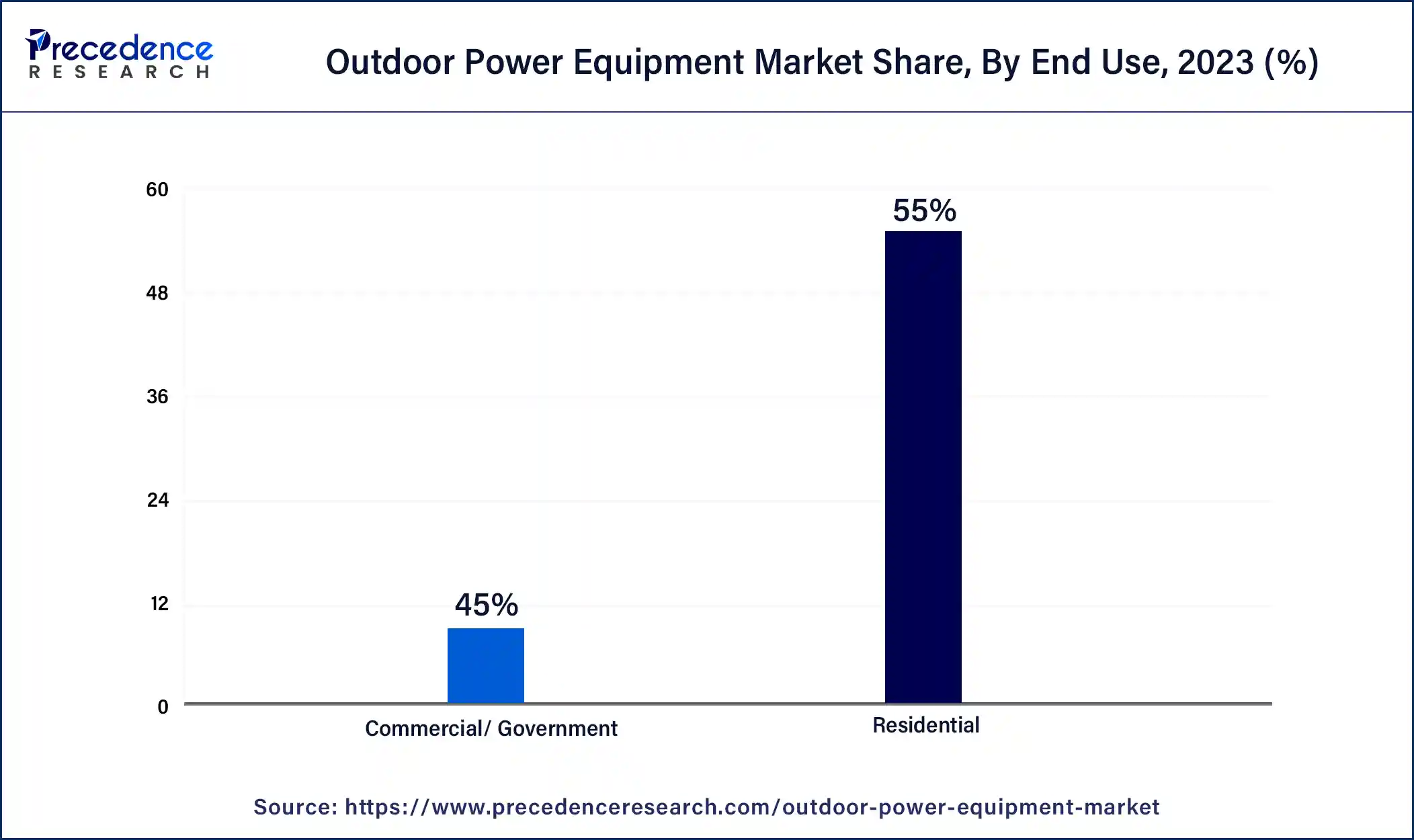
The commercial segment is expected to grow at the fastest rate in the outdoor power equipment market over the forecast period. Equipment for commercial customers, like golf courses, governments, and landscaping businesses, needs to be both extremely robust and highly efficient. This increases the need for high-performing instruments that can endure frequent use and provide reliable outcomes. Improved engine performance, extended runtime, and improved ergonomics are just a few examples of the cutting-edge features and technologies frequently seen in commercial outdoor power equipment.
Mowers, trimmers, blowers, and chainsaws are just a few of the equipment types available in the commercial market. Every kind of equipment has a unique purpose, ranging from heavy-duty tree trimming to extensive lawn maintenance. Regular maintenance and servicing are typically necessary for commercial users to guarantee that their equipment continues to operate at its best. As a result, support systems and service networks that are suited to business requirements are expanding.
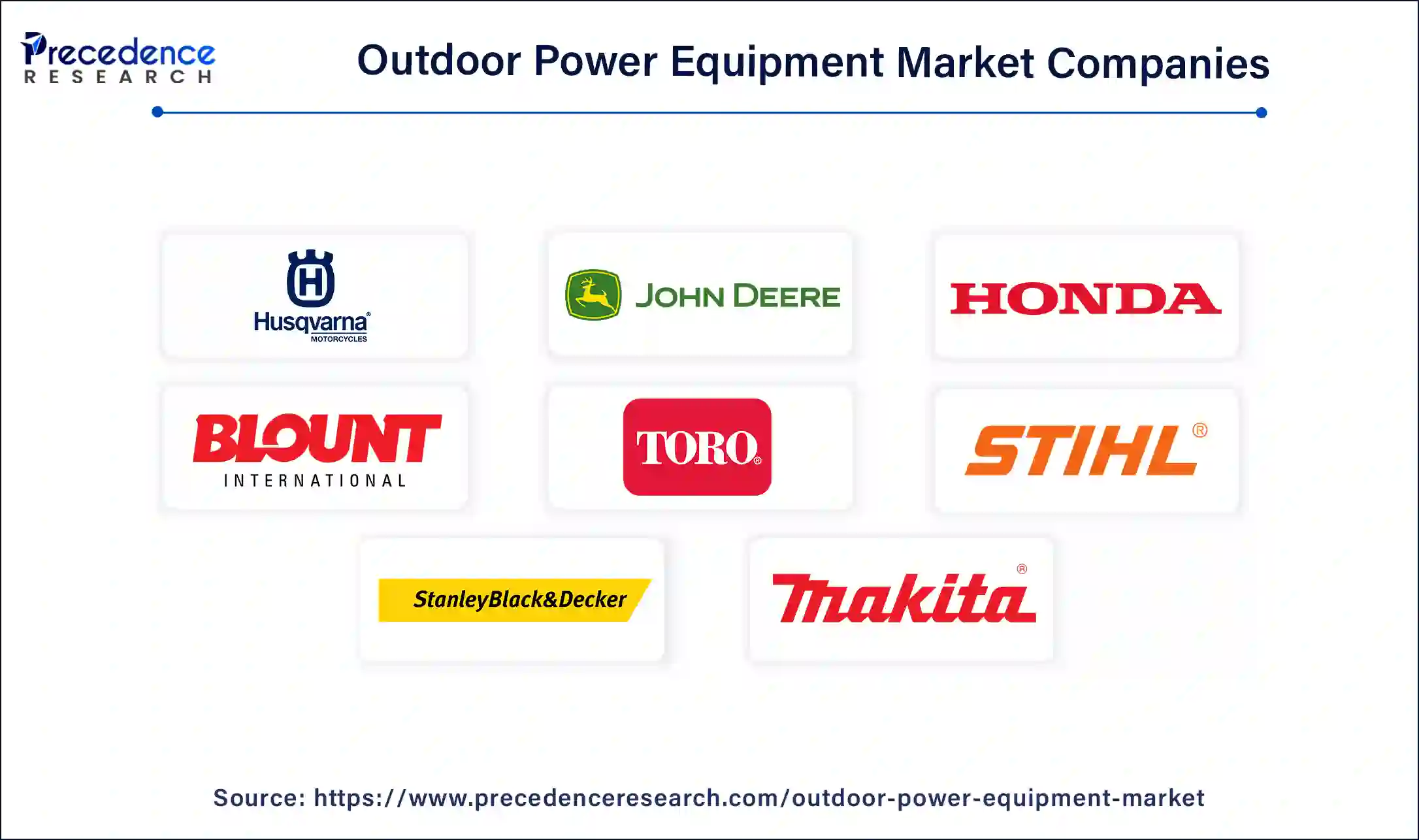
Segment Covered in the Report
By Power Source
By Equipment
By End-use
By Geography
For inquiries regarding discounts, bulk purchases, or customization requests, please contact us at sales@precedenceresearch.com
No cookie-cutter, only authentic analysis – take the 1st step to become a Precedence Research client
January 2025
August 2024
January 2025
January 2025